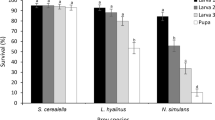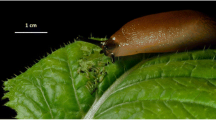Abstract
Laboratory measurements of the functional response of adultCurinus coeruleus (Mulsant) to nymphs ofHeteropsylla cubana Crawford on filter paper and on leaves of different host plants showed a significant effect of these different substrates on nymph consumption at several different densities. Moreover, this effect may be explained by the influence of the substrate on the search rate of the predator. Host plants tested includedLeucaena leucocephala (Lam) de Witt,L. diversifolia (Schlecht.) Benth. andL. pallida Britton and Rose.
Results obtained may be relevant to plant-protection research programs involving the integration of biological control with host-plant resistance.
Résumé
Des résultats obtenus en laboratoire sur la réponse fonctionnelle des adultes deCurinus coeruleus (Mulsant) aux nymphes deHeteropsylla cubana Crawford sur des substrats differents ont révété un effet significatif du substrat sur l'ingestion des nymphes à différents densités. Les substrats utilisés étaient composés de matière foliaire deLeucaena leucocephala (Lam) de Wit d'espèces apparentées en plus d'un substrat de papier comme témoin.
Les résultats obtenus pourraient être utiles en ce qui concerne des projets intégrant lutte biologique et sélection de variétés résistantes.
Similar content being viewed by others
References
Bergman, J. M. &Tingey, W. M. — 1979. Aspects of interaction between plant genotypes and biological controlBull. Entom. Soc. Amer., 25, 275–279.
Brewbaker, J. L. — 1987. Revision of the genusLeucaena. Leucaena ResearchReports 7(2) 6–20.
van Emden, H. F. & Way, M. J. —1972. Host plants in the population dynamics of insects.In: Insect/Plant Relationships (H. F. van Emden, ed.),Symp. Royal Entomol. Soc. London, 6, 181–199.
Frazer, B. D. &Gilbert N. E. — 1976. Coccinellids and aphids: a qualitative study of the impact of adult lady birds (Coleoptera: Coccinellidae) preying on field populations of pea aphids (Homoptera: Aphididae).J. Ent. Soc. Br. Columb., 73, 33–56.
Funasaki, G. Y., Lai P. Y. & Nakahara, L. M. — 1989. Status of natural enemies ofHeteropsylla cubana Crawford (Homoptera: Psyllidae) in Hawaii.In: Leucaena Psyllid: Problems and Management (B. Napompeth & K. G. MacDicken, eds.), Proceedings of an international workshop held in Bogor, Indonesia, January 16–21, 1989 pp. 153–158.
Gutierrez, A. P., Baumgaertner, J. U. &Hagen, K. S. — 1981. A conceptual model for growth, development and reproduction in the ladybird beetle,Hippodamia convergens (Coleoptera: Coccinellidae).Can. Ent., 113, 21–33.
Gutierrez, A. P., Neuenschwander, P., Schulthess, F. Herren, H. R., Baumgaertner, J. U. Wermelinger, B., Lohr, B. &Ellis, C. K. — 1988. Analysis of biological control of cassava pests in Africa. II. Cassava mealybugPhenacoccus manihoti.J. Appl. Ecol., 25, 921–940.
Hagen, K. S., Bombosch, S. &McMurtry, J. A. — 1976. The biology and impact of predators.In Huffaker, C. B. andP. S. Messenger (eds.) Theory and Practice of Biological Control,Academic Press, New York, pp. 93–141.
Hagen, K. S. — 1986. Ecosystem analysis: plant cultivars (HPR), entomophagous species and food supplements.In: Interactions of Plant Resistance and Parasitoids and Predators of Insects (Boethel, D. J. andEikenbary, R. D. eds.)J. Wiley and Sons, New York, pp. 151–197.
Holling, C. S. — 1959. The components of predation as revealed by a study of small mammal predation of the European pine sawfly.Can. Ent., 91, 385–398.
Holling, C. S. — 1966. The functional response of invertebrate predators.Mem. Ent. Soc. Can., 48, 1–86.
Kareiva, P. andSahakian R. — 1990. Tritrophic effects of a simple architectural mutation in pea plants.Nature, 345, 433–434.
Kesten, U. — 1969. Zur Morphologie und Biologie vonAnatis ocellata (L.) (Coleoptera: Coccinellidae),Z. angew. Entomol., 63, 412–445.
Luck, R. L. 1985. Principles of arthropod predation.In Huffaker, C. B. &Rabb, R. L. (eds.) Ecological Entomology,John Wiley and Sons, New York, pp. 497–529.
Luff, M. L. — 1983. The potential of predators for pest control.Agric. Ecosyst. Environ., 10, 159–181.
Maneeratana, T. — 1989. Efficacy ofCurinus coerulus Mulsant (Coleoptera: Coccinellidae) for Biological Control of Leucaena Psyllid,Heteropsylla cubana Crawford (Homoptera: Psyllidae) in Thailand. M. S. Thesis, Kasetsart University, 88 pp.
Marks, R. J. — 1977. Laboratory studies of searching behavior byCoccinella septempunctata L. larvae.Bull. Ent. Res., 67, 235–241.
Nakahara, L., Nagamine, W., Matayoshi, S. andKumashiro, B. — 1987. Biological control program on the leucaena psyllid,Heteropsylla cubana Crawford (Homoptera: Psyllidae) in Hawaii.Leucaena Research Reports, 7(2), 39–44.
Napompeth, B. — 1989. Leucaena psyllid problems in Asia and the Pacific.In: Leucaena Psyllid: problems and Management (B. Napompeth and K. G. MacDicken eds.), Proceedings of an international workshop held in Bogor, Indonesia, January 16–21, 1989, pp. 1‐7.
Obrycki, J. J. — 1986. The influence of foliar pubescence on entomophagous species.In: Interaction of Plant Resistance and Parasitoids and Predators of Insects (D. J. Boethel andR. D. Eikenbary eds.),J. Wiley and Sons, New York, pp. 11–30.
O'Neil, R. J. — 1989. Comparison of laboratory and field measurements of the functional response ofPodisus maculiventris (Heteroptera: Pentatomidae).J. Kansas Entom. Soc., 62(2), 148–155.
Price, P. W. — 1986. Ecological aspects of host plant resistance and biological control: interactions among three trophic levels.In: Interactions of Plant Resistance and Parasitoids and Predators of Insects (D. J. Boethel andR. D. Eikenbary eds.),J. Wiley and Sons, New York, pp. 11–30.
Solomon, M. E. — 1949. The natural control of animal populations.J. Anim. Ecol., 18, 1–35.
Sorensson, C. T. andBrewbaker, J. L. — 1987. Leucaena species and genetic control options.Leucaena Research Reports, 7(2), 29–34.
Waterhouse, D. F. andNorris, K. R. — 1987. Biological Control: Pacific Prospects,Inkata Press, Melbourne, pp. 33–41.
Wheeler, R. A. — 1988. Leucaena psyllid trial at Waimanalo, Hawaii.Leucaena Research Reports, 9, 25–29.
Author information
Authors and Affiliations
Rights and permissions
About this article
Cite this article
da Silva, P.G., Hagen, K.S. & Gutierrez, A.P. Functional response ofCurinus coeruleus (Col.: Coccinellidae) toHeteropsylla cubana (Hom.: Psyllidae) on artificial and natural substrates. Entomophaga 37, 555–564 (1992). https://doi.org/10.1007/BF02372325
Received:
Accepted:
Issue Date:
DOI: https://doi.org/10.1007/BF02372325
Key-Words
- Functional response
- Curinus coeruleus
- Heteropsylla cubana
- Leucaena leucocephala
- biological control
- host-plant resistance




